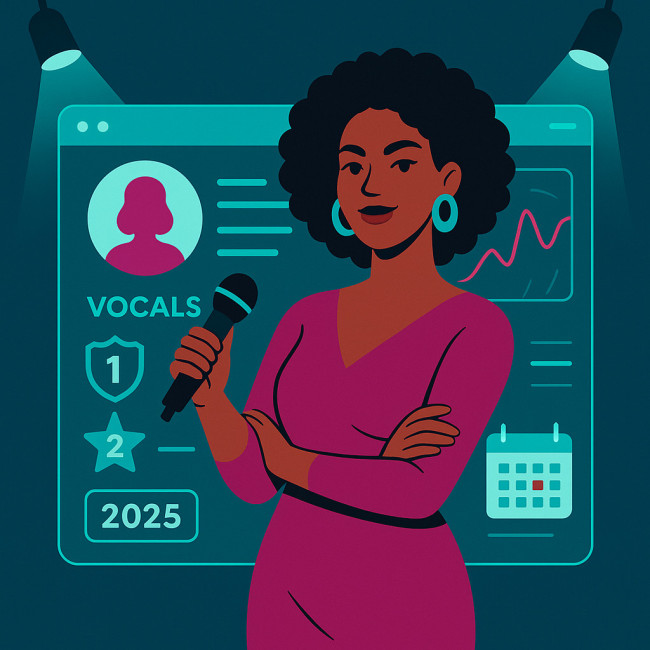Voice tech tools 2025: apps that complement external singer training programs
Looking for a way to squeeze more progress out of every coaching session? The newest voice tech tools in 2025 transform warm-ups, pitch drills and even gig prep into data-driven mini-workouts you can run anywhere. This guide shows you how to pair the right apps with your external singer training program for faster, safer and more measurable vocal growth.
Why voice tech matters in 2025
External vocal coaches remain irreplaceable for nuanced feedback, but today's practice gaps happen between lessons. Smartphones, wearables and AI engines now fill those gaps with:
- Real-time diagnostics that flag tension, pitch drift or breath leaks instantly.
- Hyper-personalised drills generated from your latest recordings, not generic scales.
- Automated progress logs you can share with your coach to refine next week's agenda.
- Remote accountability—think streak counters, habit nudges and community leaderboards.
Voice tech tools 2025: the essential categories
1. Pitch & intonation analyzers
Apps such as TuneUp Vox and PitchPilot AI offer cent-accurate tracking across five octaves. Their colour-coded waveforms highlight micro-shifts your ear may miss after long rehearsals. Export the session log and your teacher can spot chronic scoop-ups before they hard-wire.
2. Breathing & support coaches
Wearables like the Lunair Breathe Belt sync with companion apps to visualise diaphragmatic engagement. A haptic buzz alerts you when rib expansion drops below your target range. Pair this data with traditional siren exercises from your coach for a 360° breath routine.
3. AI-powered vocal health monitors
Platforms such as VocalGuard 24 record spectral fingerprints during warm-ups and issue fatigue scores. The algorithm factors hydration, ambient noise and speaking load to predict when to rest. That proactive alert helps you avoid cancellations and protect long-term career health.
4. Ear-training gamified
Interval Hero 3.0 turns interval recognition, chord ID and rhythmic dictation into swipe-based quests. Leaderboards with industry peers keep motivation high—a smart add-on if you're cultivating session-singer versatility.
5. Habit & scheduling dashboards
Apps like Setlist Scheduler merge practice plans with gig calendars. You can tag each rehearsal clip with repertoire, tempo and target vowel so your coach reviews exactly what matters. The dashboard even syncs travel alerts, making it easier to slot scales before sound-check.
Comparison table: choose your 2025 toolkit
| App | Main focus | Best for | Offline mode | Coach sharing |
|---|---|---|---|---|
| TuneUp Vox | Pitch accuracy | Lead vocalists | Yes | PDF & CSV |
| Lunair Breathe | Support & stamina | Musical-theatre singers | No | Live dashboard link |
| VocalGuard 24 | Vocal health | Touring pros | Yes | Weekly summary |
| Interval Hero 3.0 | Ear training | Session vocalists | Yes | Score export |
| Setlist Scheduler | Habit tracking | Gigging artists | Yes | Calendar invite |
Integrating apps with external coaching
- Agree on metrics. Decide with your coach which app scores matter—cent deviation, lung capacity, stamina index—so goals stay aligned.
- Share data before the lesson. Email or cloud-share practice logs 24 hours ahead. Teachers can then skip diagnostics and dive into solutions.
- Replicate studio conditions. Record exercises in the same key, tempo and vowel shapes your coach assigns. Consistency keeps AI feedback reliable.
- Schedule tech-free check-ins. Once a month, park the gadgets and run a live audition simulation. This guards against over-reliance on visual cues.
Case study: doubling range stamina in eight weeks
Soul singer Maya used Lunair Breathe alongside weekly belt-technique sessions. Her diaphragm engagement score climbed from 73 % to 89 %, extending her A4-D5 power notes by 20 seconds. She also embedded micro-habit drills to lock gains between rehearsals.
Boost your booking appeal with data-backed profiles

Recruiters scanning singer directories love objective proof. Uploading a VocalGuard health badge or sharing Interval Hero leaderboard screenshots can lift trust almost as much as audio demos. For an extra edge, refine your online portfolio images with the tactics in this optimisation guide, and ensure you appear in local talent filters.
Pitfalls to avoid
- Chasing gamified scores over artistry. Remember: a perfect interval graph doesn't guarantee emotional connection.
- Ignoring latency. Some apps process audio with minor delay; always cross-check with live piano.
- Data overload. Three core KPIs beat twenty unread dashboards. Curate what matters.
FAQ
- Can apps replace my vocal coach in 2025?
- No. Apps automate drills and monitoring, but nuanced interpretation, repertoire choice and stylistic coaching still demand human expertise.
- How often should I sync app data with my coach?
- Weekly is ideal. Consistent uploads help teachers spot patterns early and adjust lesson plans efficiently.
- Will constant monitoring strain my voice?
- Most tools use passive microphones or breath sensors and don't force extra singing. Follow fatigue alerts to avoid over-training.
- Are these apps union-approved for professional reporting?
- Several, including TuneUp Vox, export logs compatible with SAG-AFTRA health check templates, streamlining compliance.
- Where can I compare external training providers that welcome tech integration?
- Explore the dedicated singer training listings where many schools now advertise app-friendly curricula.
Ready to amplify your practice?
Combine a trusted coach, the right 2025 voice tech stack and a data-rich online profile to book more gigs and keep your voice tour-ready. Start your upgrade today and watch both your high notes and hiring rate climb.
Next step: Review the coach selection checklist to ensure your mentor is as tech-forward as you are.











